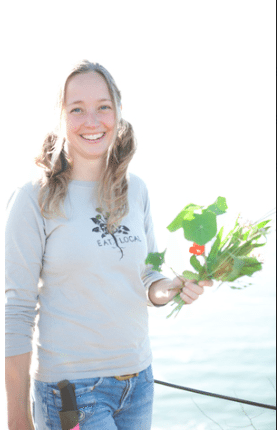by Tanya Henry
“We never called it foraging,” says Mia Andler, who describes growing up in Finland and eating plants and berries that she would find while exploring. “We just ate food from the forest.” When she moved to the United States 20 years ago, she was surprised to learn that few people did the same.
The Lagunitas resident teaches children a range of wilderness classes that include tracking, nature awareness and survival skills through her Vilda camps (named after a Finnish boat from her childhood—Vildanden, which translates to Wild Duck).
The soft-spoken naturalist moved from Tahoe to Marin In 2005 and enrolled in a naturalist training program called Kamana, taught by Jon Young at the Regenerative Design Institute in Bolinas. She describes the experience as life-changing, and it was there that she learned to produce her own food in and outside the garden.
What once appeared to her as a wall of green is now familiar, she says, and she has even learned to predict what types of plants will grow in any particular spot throughout the Bay Area.
Through her work with Sustainable Fairfax, Andler explains how she accidentally began teaching adults about foraging. “I offered a wild-food walk and over 40 people showed up!” She has been leading at least one walk a month ever since. With a deep commitment to sustainability, Andler is concerned that with the growing popularity of foraging, some might over-pick or harvest too much—not allowing plants to grow back and complete their natural cycle.
“The only way we are going to value plants is through education,” says Andler, who has co-authored a book titled, The Bay Area Forager: Your Guide to the Edible Wild Plants of the San Francisco Bay Area. Dedicated to the plants that feed us, the book features chapters that include a photograph of a specific plant, where it can be found, what it looks like and when it’s available. In addition, a recipe is provided along with a paragraph about sustainability and ways in which readers can be sure the plant or tree will continue to flourish after fruit or leaves are picked.
Andler has another book in the works that will focus on edible and useful gardens that don’t require a lot of “inputs.” She wants to show folks how to bring foraging to their homes, and offer tools for readers to create usable and purposeful gardens. For now, Andler will continue teaching her mindful brand of nature awareness. She hopes that folks will consider their interconnectedness to the land and only eat what they find on the trail—leaving some behind for others.













Foraging. Earth can support maybe a million Homo sapiens.
Gardening. Earth can support maybe 100,000,000 people
Farming. Earth can support a few billion
Agribiz. Earth can support 10 billion plus.
Which do you want?
Foraging is an elitist, non-sustainable practice